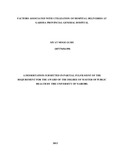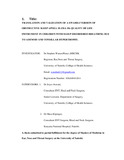| dc.description.abstract | BACKGROUND:
Sleep disorders are common and associated with multiple metabolic and psychological derangements. Obstructive sleep apnoea (OSA) is among the most common sleep disorders and an inter-relationship between OSA, insulin resistance, obesity, type 2 diabetes (T2DM) and cardiovascular diseases has been established. Prevalence of sleep disorders in Kenyans, particularly in individuals with T2DM is unknown. We thus aimed to determine prevalence of poor quality of sleep (QOS) and high risk for OSA, among persons with T2DM and determine their associations with socio-demographic and anthropometric variables.
METHODS:
Utilising a Cross- Sectional Descriptive design, QOS and risk for OSA were determined in a randomly selected sample of patients with T2DM (cases) and an age and sex matched comparison group. The validated Pittsburgh Sleep Quality Index (PSQI) and Berlin Questionnaire (BQ) were used to measure QOS and risk for OSA respectively. Associations between poor QOS, high risk for OSA, and socio-demographic and anthropometric variables in cases were evaluated.
RESULTS:
From 245 randomly selected persons with T2DM attending outpatient clinics, aged over 18 years, 22 were excluded due to ineligibility thus 223 were included in the analysis; 53.8% were females, mean age was 56.8 (SD 12.2) years and mean BMI was 28.8 kg/m2 (SD 4.4). Among them, 119 (53%, CI 95% 46.5-60.2) had poor QOS and 99 (44% CI 95% 37.8-50.9) were at high risk for OSA. Among 112 individuals in comparison group, 33 (29.5%, CI 95% 20.9-38.3) had poor QOS and 9 (8%, CI 95% 3.3-13.4) had high risk for OSA. Cases had a significantly higher probability for poor QOS [OR 2.76 (95% CI 1.7-4.4))] and high risk for OSA [OR 9.1 (95% CI 4.4-19.0)]. Higher waist circumference was independently associated with a high risk for OSA in cases.
CONCLUSIONS:
We demonstrate a high burden of sleep disturbances in patients with T2DM. Our findings may have implications for clinicians to screen for sleep disorders when assessing patients with T2DM and warranting further attention by practitioners and researches in this field. | en_US |





